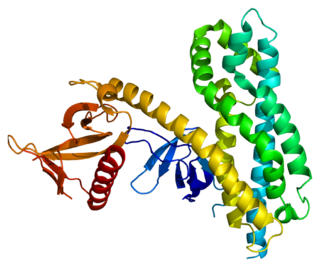Related Research Articles

Lamin B2 is a protein that in humans is encoded by the LMNB2 gene. It is the second of two type B nuclear lamins, and it is associated with laminopathies.

Trpc4-associated protein is a protein that in humans is encoded by the TRPC4AP gene.

Ephrin A1 is a protein that in humans is encoded by the EFNA1 gene.
RhoU is a small signaling G protein, and is a member of the Rho family of GTPases. Wrch1 was identified in 2001 as encoded by a non-canonical Wnt induced gene. RhoU/Wrch delineates with RhoV/Chp a Rho subclass related to Rac and Cdc42, which emerged in early multicellular organisms during evolution.

Rho guanine nucleotide exchange factor 4 is a protein that in humans is encoded by the ARHGEF4 gene.
FAM107B is a gene found in humans. It is located on the minus strand of chromosome 10, p13, which is on the short arm of the chromosome. It has other alias names, such as C10orf45, FLJ45505, MGC11034 and MGC90261. The gene contains a conserved domain, DUF1151, which is a family that consists of several eukaryotic proteins of unknown function. FAM107B is expressed in most tissues in the human body without there being a high frequency in any one tissue. It is found in all stages of human development.

HMG box transcription factor BBX also known as bobby sox homolog or HMG box-containing protein 2 is a protein that in humans is encoded by the BBX gene.

Integrator complex subunit 12 (Int12) also known as PHD finger protein 22 (PHF22) is a protein that in humans is encoded by the INTS12 gene.

MDN1, midasin homolog (yeast) is a protein that in humans is encoded by the MDN1 gene. Midasin is a member AAA ATPase family.

Mitochondrial methionyl-tRNA formyltransferase is a protein that in humans is encoded by the MTFMT gene.

Coiled-coil domain containing 137 is a protein that in humans is encoded by the CCDC137 gene.

Eukaryotic translation initiation factor 4E family member 3 is a protein that in humans is encoded by the EIF4E3 gene.

Solute carrier family 41, member 3 is a protein that in humans is encoded by the SLC41A3 gene.

Mitochondrial 2-oxodicarboxylate carrier also known as solute carrier family 25 member 21 (SLC25A21) is a protein that in humans is encoded by the SLC25A21 gene.

Rho GTPase activating protein 25 is a protein that in humans is encoded by the ARHGAP25 gene. The gene is also known as KAIA0053. ARHGAP25 belongs to a family of Rho GTPase-modulating proteins that are implicated in actin remodeling, cell polarity, and cell migration.
Solute carrier family 25, member 29 is a protein that in humans is encoded by the SLC25A29 gene. The gene is also known as CACL and C14orf69. SLC25A29 belongs to a protein family of solute carriers called the mitochondrial carriers.
RNA (guanine-9-) methyltransferase domain containing 2 is a protein that in humans is encoded by the RG9MTD2 gene. The gene is also known as TRM10.
Glutamyl-tRNA(Gln) amidotransferase, subunit C homolog (bacterial) is a protein that in humans is encoded by the GATC gene. The gene is also known as 15E1.2 and encodes part of a Glu-tRNA(Gln) amidotransferase enzyme.
Family with sequence similarity 104, member A is a protein that in humans is encoded by the FAM104A gene. The orthologous gene in mice is also known as D11Wsu99e.
Zinc finger protein 367 is a protein that in humans is encoded by the ZNF367 gene. The human gene is also known as ZFF29 and CDC14B; the orthologue in mice is Zfp367. ZNF367 contains a unique Cys2His2 zinc finger motif and is a member of the zinc finger protein family.
References
- ↑ Davis S, Aldrich TH, Valenzuela DM, Wong VV, Furth ME, Squinto SP, Yancopoulos GD (1991). "The receptor for ciliary neurotrophic factor". Science. 253 (5015): 59–63. Bibcode:1991Sci...253...59D. doi:10.1126/science.1648265. PMID 1648265.
- ↑ Sleeman MW, Anderson KD, Lambert PD, Yancopoulos GD, Wiegand SJ (2000). "The ciliary neurotrophic factor and its receptor, CNTFR alpha". Pharm Acta Helv. 74 (2–3): 265–72. doi:10.1016/S0031-6865(99)00050-3. PMID 10812968.
- ↑ "Salmonella infection data for Cntfr". Wellcome Trust Sanger Institute.
- ↑ "Citrobacter infection data for Cntfr". Wellcome Trust Sanger Institute.
- 1 2 3 Gerdin AK (2010). "The Sanger Mouse Genetics Programme: High throughput characterisation of knockout mice". Acta Ophthalmologica. 88 (S248). doi:10.1111/j.1755-3768.2010.4142.x. S2CID 85911512.
- ↑ Mouse Resources Portal, Wellcome Trust Sanger Institute.
- ↑ "International Knockout Mouse Consortium". Archived from the original on 2012-06-02. Retrieved 2011-12-24.
- ↑ "Mouse Genome Informatics".
- ↑ Skarnes, W. C.; Rosen, B.; West, A. P.; Koutsourakis, M.; Bushell, W.; Iyer, V.; Mujica, A. O.; Thomas, M.; Harrow, J.; Cox, T.; Jackson, D.; Severin, J.; Biggs, P.; Fu, J.; Nefedov, M.; De Jong, P. J.; Stewart, A. F.; Bradley, A. (2011). "A conditional knockout resource for the genome-wide study of mouse gene function". Nature. 474 (7351): 337–342. doi:10.1038/nature10163. PMC 3572410 . PMID 21677750.
- ↑ Dolgin E (June 2011). "Mouse library set to be knockout". Nature. 474 (7351): 262–3. doi: 10.1038/474262a . PMID 21677718.
- ↑ Collins FS, Rossant J, Wurst W (January 2007). "A mouse for all reasons". Cell. 128 (1): 9–13. doi: 10.1016/j.cell.2006.12.018 . PMID 17218247. S2CID 18872015.
- ↑ van der Weyden L, White JK, Adams DJ, Logan DW (2011). "The mouse genetics toolkit: revealing function and mechanism". Genome Biol. 12 (6): 224. doi:10.1186/gb-2011-12-6-224. PMC 3218837 . PMID 21722353.